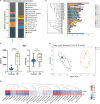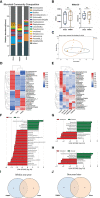Conjunctival sac microbiome in anophthalmic patients: Flora diversity and the impact of ocular prosthesis materials
- PMID: 36960044
- PMCID: PMC10027910
- DOI: 10.3389/fcimb.2023.1117673
Conjunctival sac microbiome in anophthalmic patients: Flora diversity and the impact of ocular prosthesis materials
Abstract
Purpose: To explore the changes of bacterial flora in anophthalmic patients wearing ocular prosthesis (OP) and the microbiome diversity in conditions of different OP materials.
Methods: A cross-sectional clinical study was conducted, involving 19 OP patients and 23 healthy subjects. Samples were collected from the upper, lower palpebral, caruncle, and fornix conjunctiva. 16S rRNA sequencing was applied to identify the bacterial flora in the samples. The eye comfort of each OP patient was determined by a questionnaire. In addition, demographics information of each participant was also collected.
Results: The diversity and richness of ocular flora in OP patients were significantly higher than that in healthy subjects. The results of flora species analysis also indicated that in OP patients, pathogenic microorganisms such as Escherichia Shigella and Fusobacterium increased significantly, while the resident flora of Lactobacillus and Lactococcus decreased significantly. Within the self-comparison of OP patients, compared with Polymethyl Methacrylate (PMMA), prosthetic material of glass will lead to the increased colonization of opportunistic pathogens such as Alcaligenes, Dermabacter and Spirochaetes, while gender and age have no significant impact on ocular flora.
Conclusions: The ocular flora of OP patients was significantly different from that of healthy people. Abundant colonization of pathogenic microorganisms may have an important potential relationship with eye discomfort and eye diseases of OP patients. PMMA, as an artificial eye material, demonstrated potential advantages in reducing the colonization of opportunistic pathogens.
Keywords: anophthalmia; conjunctival sac; microbiome; ocular prosthesis; ocular surface flora.
Copyright © 2023 Zhao, Chen, Zheng, Xu, Zhang, Fu and Xiong.
Conflict of interest statement
The authors declare that the research was conducted in the absence of any commercial or financial relationships that could be construed as a potential conflict of interest.
Figures






Similar articles
-
Microbiological evaluation of conjunctival anopthalmic flora after using digital 3D-printed ocular prosthesis compared to conventional one: a randomized clinical trial.BMC Oral Health. 2023 Dec 18;23(1):1012. doi: 10.1186/s12903-023-03746-w. BMC Oral Health. 2023. PMID: 38110937 Free PMC article. Clinical Trial.
-
Study of conjunctival flora in anophthalmic patients: influence on the comfort of the socket.Graefes Arch Clin Exp Ophthalmol. 2017 Aug;255(8):1669-1679. doi: 10.1007/s00417-017-3708-8. Epub 2017 Jun 10. Graefes Arch Clin Exp Ophthalmol. 2017. PMID: 28601909
-
Concerns of anophthalmic patients-a comparison between cryolite glass and polymethyl methacrylate prosthetic eye wearers.Graefes Arch Clin Exp Ophthalmol. 2018 Jun;256(6):1203-1208. doi: 10.1007/s00417-018-3942-8. Epub 2018 Mar 3. Graefes Arch Clin Exp Ophthalmol. 2018. PMID: 29502234
-
Ocular Surface Microbiome in Health and Disease.Asia Pac J Ophthalmol (Phila). 2020 Dec;9(6):505-511. doi: 10.1097/APO.0000000000000330. Asia Pac J Ophthalmol (Phila). 2020. PMID: 33323705 Review.
-
The Ocular Microbiome: Molecular Characterisation of a Unique and Low Microbial Environment.Curr Eye Res. 2019 Jul;44(7):685-694. doi: 10.1080/02713683.2019.1570526. Epub 2019 Feb 4. Curr Eye Res. 2019. PMID: 30640553 Review.
Cited by
-
Microbiological evaluation of conjunctival anopthalmic flora after using digital 3D-printed ocular prosthesis compared to conventional one: a randomized clinical trial.BMC Oral Health. 2023 Dec 18;23(1):1012. doi: 10.1186/s12903-023-03746-w. BMC Oral Health. 2023. PMID: 38110937 Free PMC article. Clinical Trial.
-
[Microbiological view of the anophtalmic cavity].Rev Esp Quimioter. 2025 Feb;38(1):72-74. doi: 10.37201/req/089.2024. Epub 2024 Nov 21. Rev Esp Quimioter. 2025. PMID: 39569423 Free PMC article. Spanish. No abstract available.
-
Prevalence and antimicrobial susceptibility patterns of bacteria colonizing the external ocular surfaces of patients undergoing ocular surgeries at Bugando Medical Center in Mwanza, Tanzania.BMC Res Notes. 2024 Jul 11;17(1):193. doi: 10.1186/s13104-024-06851-3. BMC Res Notes. 2024. PMID: 38992706 Free PMC article.
-
Altered ocular surface microbiota in obesity: a case-control study.Front Cell Infect Microbiol. 2024 Mar 12;14:1356197. doi: 10.3389/fcimb.2024.1356197. eCollection 2024. Front Cell Infect Microbiol. 2024. PMID: 38533385 Free PMC article.
References
MeSH terms
Substances
LinkOut - more resources
Full Text Sources
Miscellaneous

